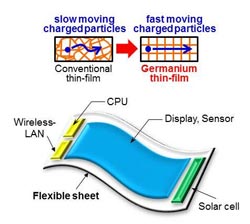Growing Thin Films of Germanium

Kyushu Univ./T. Sadoh<br><br>High-speed germanium thin-film transistors enable next-generation electronics.<br>
Researchers have developed a new technique to produce thin films of germanium crystals — key components for next-generation electronic devices such as advanced large-scale integrated circuits and flexible electronics, which are required for gadgets that move or bend.
Unlike conventional methods, the new approach does not require high temperatures or other crystals to act as seeds to grow the germanium crystal. And, the researchers say, the new method can be used to produce germanium films with a very large area, allowing for more potential applications.
“This is the realization of the dreams of crystal-growth researchers,” says Taizoh Sadoh of Kyushu University. “This unique method will open new ways to create advanced flexible electronics.”
Sadoh is an author of the paper describing the new work, which appears in the AIP Publishing journal Applied Physics Letters.
Charged particles move through germanium more readily than they do through silicon, making germanium a good material for electronics. In particular, it is a promising material for the thin-film transistors that are needed for flexible electronics. However, for use in flexible electronics, the germanium would have to be grown on malleable materials, which tend to soften at temperatures above 300° Celsius. The challenge, said Sadoh, is to grow germanium at lower temperatures.
Using gold as a catalyst, Sadoh and his colleagues were able to grow germanium crystals at a temperature of about 250° Celsius. They were also able to grow them in such a way that their crystal structure has the proper orientation and electrical properties necessary for technological applications.
The paper, “Nucleation controlled gold-induced-crystallization for selective formation of Ge(100) and (111) on insulator at low-temperature (~250° C)” by Jong-Hyeok Park, Tsuneharu Suzuki, Masahi Kurosawa, Masanobu Miyao and Taizoh Sadoh appears in the journal Applied Physics Letters. See: http://dx.doi.org/10.1063/1.4819015
ABOUT THE JOURNAL
Applied Physics Letters features concise, rapid reports on significant new findings in applied physics. The journal covers new experimental and theoretical research on applications of physics phenomena related to all branches of science, engineering, and modern technology. See: http://apl.aip.org
Media Contact
More Information:
http://www.aip.orgAll latest news from the category: Physics and Astronomy
This area deals with the fundamental laws and building blocks of nature and how they interact, the properties and the behavior of matter, and research into space and time and their structures.
innovations-report provides in-depth reports and articles on subjects such as astrophysics, laser technologies, nuclear, quantum, particle and solid-state physics, nanotechnologies, planetary research and findings (Mars, Venus) and developments related to the Hubble Telescope.
Newest articles

A universal framework for spatial biology
SpatialData is a freely accessible tool to unify and integrate data from different omics technologies accounting for spatial information, which can provide holistic insights into health and disease. Biological processes…

How complex biological processes arise
A $20 million grant from the U.S. National Science Foundation (NSF) will support the establishment and operation of the National Synthesis Center for Emergence in the Molecular and Cellular Sciences (NCEMS) at…

Airborne single-photon lidar system achieves high-resolution 3D imaging
Compact, low-power system opens doors for photon-efficient drone and satellite-based environmental monitoring and mapping. Researchers have developed a compact and lightweight single-photon airborne lidar system that can acquire high-resolution 3D…





















